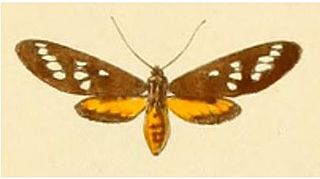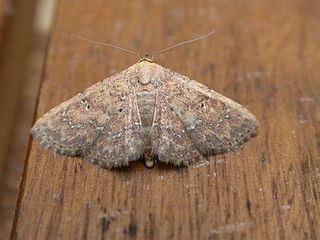Related Research Articles

The following is a list of public holidays in Romania. According to Romanian law, Romania had 51 public holidays as of 2011, which cover 14% of the days of the year in the country.

Gracillariidae is an important family of insects in the order Lepidoptera and the principal family of leaf miners that includes several economic, horticultural or recently invasive pest species such as the horse-chestnut leaf miner, Cameraria ohridella.

Maculonaclia is a genus of moths in the subfamily Arctiinae. The genus was erected by Paul Griveaud in 1964.
Viettesia is a genus of moths in the subfamily Arctiinae from Madagascar. The genus was erected by Hervé de Toulgoët in 1959.

Cerynea is a genus of moths of the family Erebidae erected by Francis Walker in 1859.
Hypsiforma is a genus of moths of the family Erebidae. The genus was first described by Oberthür in 1923. The species are found on Madagascar.

Gonometa is a genus of moths in the family Lasiocampidae. The genus was erected by Francis Walker in 1855.
Dyschlorodes is a genus of moths in the family Geometridae erected by Claude Herbulot in 1966. All the species in this genus are from Madagascar.
Lasiochlora is a genus of moths in the family Geometridae described by Warren in 1894.

Lophostethus dumolinii is a moth of the family Sphingidae. It is known from most habitats, except desert and high mountains throughout the Ethiopian Region, excluding Madagascar and the Cape in South Africa.
Melanastia is a monotypic snout moth genus described by George Hampson in 1930. Its only species, Melanastia bicolor, described in the same article, is found in Nigeria and South Africa.

Stenoglene is a genus of moths in the family Eupterotidae from Africa. The genus was described by Felder in 1874.
Paraona bicolor is a moth of the family Erebidae. It was described by Hervé de Toulgoët in 1968. It is found on Madagascar.
Teracotona euprepia is a moth in the family Erebidae. It was described by George Hampson in 1900. It is found in Angola, the Democratic Republic of the Congo, Malawi, South Africa, Tanzania, Uganda and Zimbabwe.
Viettesia bicolor is a moth in the subfamily Arctiinae. It was described by Hervé de Toulgoët in 1980. It is found on the Comoros in the Indian Ocean.
Protepicorsia bicolor is a moth in the family Crambidae. It was described by Eugene G. Munroe in 1964. It is found in Santa Catarina, Brazil.
Stenoglene bicolor is a moth in the family Eupterotidae. It was described by William Lucas Distant in 1897. It is found in South Africa.

A Kambo cleansing, also known as a Kambo circle or Kambo ceremony, Kambo, vacina-do-sapo, or sapo, is a purge using skin secretions of the kambô, a species of frog. The effects on humans usually include nausea, vomiting, and diarrhea; use of kambo has caused several deaths. Kambo, which originated as a folk medicine practice among the Amazon indigenous peoples, is also administered as an alternative medicine treatment in the West, often as a pseudoscientific cleanse or detox. The ceremony involves burning an arm or leg and applying the kambo secretion directly to the burn. Promoters claim that kambo helps with several illnesses or injuries. There is no scientific evidence that it is an effective treatment.
References
- Citations
- ↑ De Prins, J. & De Prins, W. (2017). "Asparus bicolor (Walker, 1855)". Afromoths. Retrieved December 4, 2017.
- Bibliography